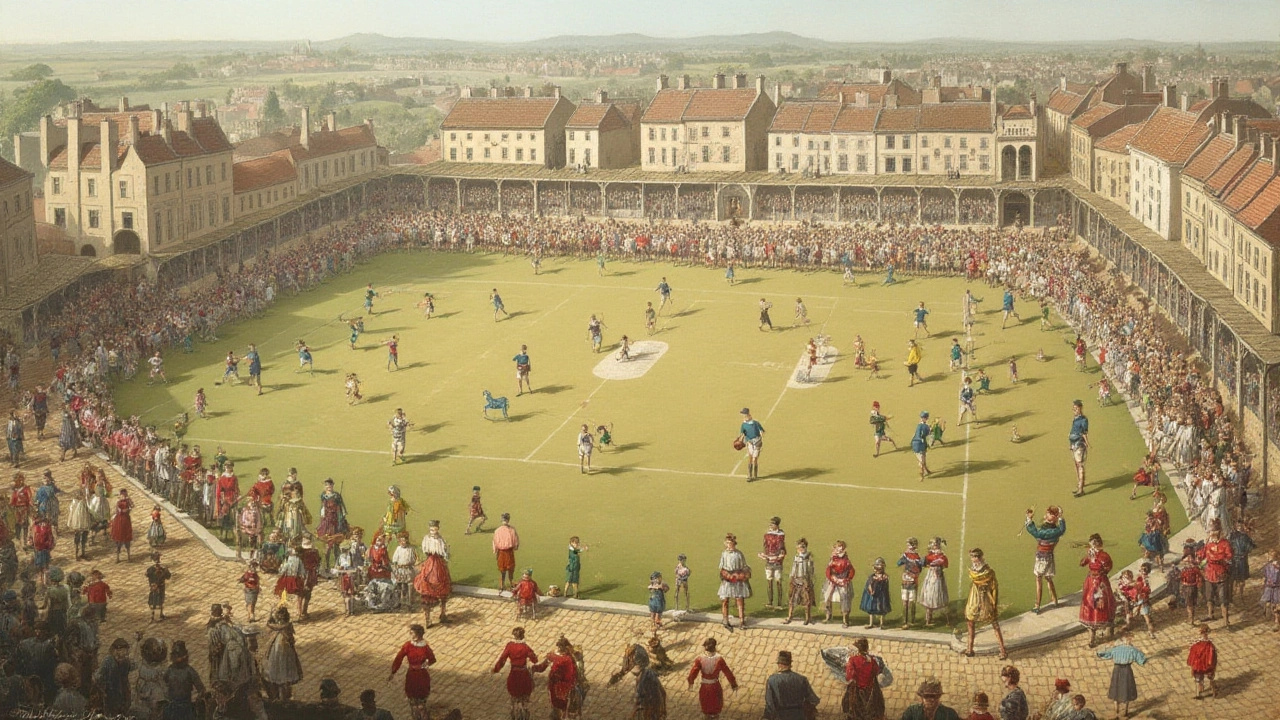The Origin of Rugby: Unraveling the Early Days of Rugby

The tale of rugby's beginnings is as storied as the sport itself. It takes us back to the early 1800s, weaving through the corridors of Rugby School, an institution in England, where it's often said the game first took shape. Legend has it that in 1823, a young student named William Webb Ellis, exhibiting what many view as audacious creativity or rebellious spirit, decided to take the ball in his hands and race towards the goal during a school football match. This moment, immortalized in rugby folklore, is credited with the sport's unconventional inception.
While the Webb Ellis story adds a touch of romance to the tale of rugby, the more down-to-earth transformation of traditional folk games into what we now recognize as rugby was a gradual process. Variants of football, boasting permissible use of hands, paired with a diversity of local customs, brought this thrilling, chaotic game to life over many decades. By the time the 1860s rolled around, rugby had begun to shape up with the formation of rules, spearheading its journey to organized sport status.
The Myth of William Webb Ellis
The story of William Webb Ellis is one of those charming legends that sports history often provides. It's a tale that has survived through centuries, despite being wrapped in a fog of myth and speculation. The narrative describes a day in 1823 when a young student, Ellis, spontaneously picked up the ball during a football match and dashed towards the opposition's goal line, defying the conventional rules of the game being played. This act of boldness, the story suggests, laid the groundwork for what we now know as rugby. However, no one saw fit to document this game-changing event in detail at the time, so many question its authenticity.
The first mention of this story appeared decades later, in 1876, by Old Rugbeian Matthew Bloxam. His anecdotal account was published in the school magazine, but even he expressed skepticism about its truth, having no firsthand witnesses to confirm it. This raises questions about the factual basis of the story. Some historians dismiss it as a romanticized creation, while others accept it as a symbol of rugby's spirit — honoring ingenuity and courage over rigid adherence to tradition. A core truth within this legend is how certain moments, factual or not, can embody the essence of a sport and its values.
Despite the mystery surrounding the tale, Rugby School embraced it wholeheartedly. In 1895, a commemorative plaque was installed at the school, forever linking Ellis’s name with the birth of rugby. Yet, the lack of evidence hasn’t stopped the story from being celebrated and repeated worldwide. After all, history often enjoys a good narrative, particularly one that captures the imagination and incites pride among participants and fans alike. Still, the story serves as a rich tapestry over which the precise details of rugby's origin can be debated, providing both historians and fans with endless speculation.
Modern rugby embraces William Webb Ellis as a mythic figure, with his legacy swimming in a blend of reality and fiction. His supposed play became emblematic of rugby's distinct difference from its close cousin, football. In recognizing this, it’s important to consider the cultural impact of such legends. While tangibility evades this tale, the essence of Ellis’s moment — a moment of impulse and innovation — resonates with the sport’s dynamic nature.
"The advantage of rugby lies in its simplicity and the essentials of play that were likely shown by Webb Ellis, though some nuances may have been added later." - A renowned rugby historian
As the story goes, the infamous action wasn’t a clearly defined blueprint of rugby but rather a snapshot of reformative thinking. Perhaps unknowingly, Ellis’s legend collects all the scattered pieces of rugby's complex beginnings into a single narrative strand, binding them with myth and imagination. Ironically, the simplicity of this tale has made it impactful throughout the decades. Each time it's retold, it inspires and rekindles the core spirit of inventiveness within teams and players on a global scale.

Rugby School's Role
Tucked away in the English countryside, Rugby School played a significant role in the birth and development of the sport we now know as rugby. As the legend goes, it was here in 1823 that young William Webb Ellis defied the norms of the day, sparking a playful revolution by taking the ball in his hands and running towards the opponent's goal. This act, though largely anecdotal and romanticized, symbolizes the school's connection to the sport's formative years. But aside from folklore, Rugby School provided fertile ground for a new, robust type of football that emphasized physical skill and teamwork.
The culture within Rugby School encouraged the spirit of innovation. The institution was renowned for its enthusiastic embrace of sports as a critical element of education. This environment was crucial as it introduced a structured but evolving playing field where students indulged freely in experimentation with the rules of existing games. Thus, rugby did not just spring up from a single action but was nurtured from the soil of competitive youth and progressive educational philosophies. The school's headmasters and faculty played their parts too, emphasizing fair play and sportsmanship which harmonized well with the emerging structure of rugby.
During the mid-19th century, Rugby School's influence grew as its distinct style of play began to pique interest beyond its gates. Former students carried the game to universities and other schools, spreading not just the concept but varied rules that sometimes clashed and blended with local customs. By 1845, the first written rules of rugby were documented by the school's pupils. Known as "The Laws of Football as Played at Rugby School", these early regulations provided a framework that was fundamental to the eventual codification of the sport.
"Rugby is a game that was born of boys and matured within their imagination," notes renowned historian Nigel Brown, capturing the dynamic spirit that the school infused into the sport.
The reputation of Rugby School and its students as leaders in sports education cannot be overstated. The adoption of their game by prestigious universities like Oxford and Cambridge acted as a catalyst for rugby's gradual acceptance and formal organization. As the school thrived, so did the sport, with clubs forming and matches playing out across England. Rugby School's contribution to the sport has not faded; it gives the world rugby tournaments like the All-Schools Cup, maintaining a legacy that exceeds mere bricks and mortar, living vibrantly in the athletic spirit it has inspired worldwide.

Evolution of the Rules
The journey of rugby from its uncodified roots to the structured game we see today is a fascinating chronicle of innovation and adaptation. In the early days, rugby resembled a chaotic blend of football variations spread across the English countryside. Different towns and schools had their own interpretations, each with a distinct flavor of play. This lack of standardized rules made inter-town competitions a mess, often leading to disputes. It wasn't until the formation of the Rugby Football Union (RFU) in 1871 that things started taking shape. The RFU was formed by twenty-one clubs meeting in London, aiming to establish formal guidelines and bring consistency to the sport that was quickly gaining traction across regions.
One pivotal moment in this evolution occurred in the 1860s. Prior to this, players often used their hands but could also kick the ball, a combination derived from both rugby and soccer-like games. While the chaotic nature of early matches kept the spirit of unpredictability alive, it necessitated a move toward uniformity. The RFU's involvement was integral to defining what was permissible on the field. This push towards organization was timely, as different rule books were floating around, creating confusion. The focus was to settle key points such as the size of the pitch, the shape and size of the goal, and perhaps most importantly, codifying the ways in which the ball could be used. This brought about the famous distinction between passing backward and kicking forward, which remains one of the defining characteristics of rugby.
As the rugby history continued to unfold, the differences between rugby union and rugby league became more pronounced. These variations were largely shaped by their divergent rule sets. Rugby league, which broke away in the late 19th century, introduced changes such as reducing the number of players on each side from 15 to 13 and altering the tackle rules for a faster-paced game. Both branches aimed to cater to the interests of their specific audiences and geographic regions. It's interesting to note that during these times, rugby wasn't just sport but a reflection of societal structures, with public schools wielding immense influence over the establishment of norms. This historical backdrop provided a canvas for the modern game to evolve on, blending tradition with emerging sporting ideologies.
The international expansion of rugby played a crucial role in shaping its rules as well. As the sport spread to Australia, New Zealand, South Africa, and beyond, each region brought its own touch to the game. This expansion necessitated a global consensus on rules, leading to the formation of the International Rugby Board in 1886. Initially, it focused on northern hemisphere countries, but as rugby's popularity grew worldwide, it took on a more inclusive role. This body has been responsible for aligning the rules across countries, ensuring that matches played anywhere from the muddy fields of England to the sun-drenched stadiums of Sydney adhered to a shared set of principles.
The Development of Tactical Play
The evolution of rugby rules didn’t just stop at basic gameplay. It extended into the tactical realm, allowing teams to develop complex strategies and formations. The introduction of standardized rules enabled coaches and players to explore various offensive and defensive tactics. For instance, the scrum and line-out, essential parts of modern rugby, were refined over time, demanding both physical prowess and strategic intelligence. The art of rucking and mauling also evolved, with players realizing the importance of maintaining possession and territory, which are fundamental strategies in today’s matches.
"The glory of sport is that it brings people together." – A sentiment echoed across rugby’s development, illustrating its unifying nature despite the various trials and changes through its history.
| Year | Development |
|---|---|
| 1871 | Formation of Rugby Football Union |
| 1886 | International Rugby Board established |
| 1895 | Rugby League split, creating distinct code |
Embracing such intricate development made rugby not just a set of defined actions on the field but a true test of skill, teamwork, and strategic depth. As we trace the rugby origin back to its grassroots, its growth over the decades is a testament to the game's enduring appeal and the delights it holds for its diverse, global following. It stands today not only as a sport but as a legacy of teamwork, cultural exchange, and passionate community spirit.

Rugby's Global Expansion
Rugby's journey from the quaint, leafy grounds of Rugby School to the wider world is nothing short of a sporting odyssey. As the game solidified its rules and became more standardized in the late 19th century, it rapidly spread beyond Britain's shores. The expansion of the British Empire played a significant role in this dissemination. Enthusiastic colonizers and soldiers took the game to distant corners, including Australia, New Zealand, and South Africa. The sport found fertile ground there, not just surviving but thriving in these new contexts where local traditions and vibrant cultures embraced it with open arms. Its incorporation into educational curriculums in these regions helped entrench rugby in the sporting psyche of these nations. Schools and universities became breeding grounds for emerging talents, aiding in the creation of a competitive spirit that matched and sometimes surpassed their British forebears.
As every nation shaped rugby to its own cultural style, the game evolved uniquely across the world, creating a rich tapestry of playing styles and traditions. In New Zealand, a deep-rooted tribal heritage blended seamlessly with rugby, creating the legendary All Blacks, known for their powerhouse performances and the awe-inspiring pre-game haka. Across the Tasman Sea, Australia developed its own fierce brand of rugby. Here, the Wallabies, as they are known, brought a distinctive style to the sport. South Africa, with its own tumultuous history, saw rugby transform into more than a game – becoming a symbol of unity during the country's post-apartheid era. Nelson Mandela himself saw the 1995 Rugby World Cup as a unifying moment, famously stating,
"Sport has the power to change the world. It has the power to inspire. It has the power to unite people in a way that little else does."
The sport continued its march across continents, reaching other parts of Africa, Europe, and eventually North America. France, captivated by rugby's physicality and strategic depth, embraced it heartily, developing fierce rivalries with their British neighbors. Meanwhile, in Argentina, the sport gained traction due to the British community there, and soon the Pumas made waves on the international scene. In North America, particularly in Canada and the USA, rugby found a niche audience. While American football reigned supreme, rugby's appeal has grown steadily, driven by a love for the sport's complexity and community. Today, countries with little traditional connection to rugby, like Japan, have become powerhouses, as evidenced by their historic performances in recent World Cups.
The global growth of rugby has been bolstered by the IRB Rugby World Cup, a tournament that invites nations to showcase their prowess on a world stage, increasing the sport’s visibility and accessibility. With each passing World Cup, nations that were once considered underdogs have stepped up, challenging the traditional powerhouses. This has sparked a marvelous rivalry among teams and nations, offering fans thrilling competitions every season. To see how strategic and bold plays, inspired by different national identities and customs, clash and combine in a game is something truly remarkable, reminding us of the universality of sport. The future of rugby promises even more globalization, with programs focusing on Africa, Asia, and the Americas seeking to tap into new talent pools and expand the game's reach.

